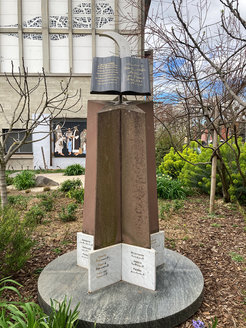Interreligious dynamics in Alsace, an exception to the rule in France
by Hande Senguler – University of Strasbourg

When Alsace-Lorraine returned to French rule, after having been under German sovereignty, it remained a distinct and important centre for religious cultures, a legacy of its centuries-old local tradition. As Alsace-Lorraine was part of Germany during the imposition of the Law of Separation of Church and State of 9 December 1905, it was excluded from the imposition of secularism (or laicité) and retained state funding for its religious institutions and the salaries of its priests, pastors and rabbis.
Despite the diverse religious landscape in Alsace, as in the rest of France, the majority religious group among the recognised cults is the Catholic Church, followed by the Protestants, who are divided into different denominational trends - mainly the Lutheran and Reformed Churches, while noting the presence of Evangelical Protestants. The last recognised religion in Alsace, although we do not have exact statistics, is Judaism. With a strong majority of the Ashkenazi tradition, the Consistoire Israélite du Bas-Rhin was at the centre of Jewish life in Strasbourg, more so than in other cities in France. From 1936 onwards, Strasbourg and its surroundings received more than 10,000 Jews, mainly migrants from Germany and Eastern Europe, in contrast to Marseille and Paris, which also had Jews from the Mediterranean countries, and therefore from the Sephardic tradition.
For the [officially] non-recognised religions in Alsace, Islam is the third most important religious group in the region. Mainly the result of immigration, this religious group is singularly composed of Turks, Moroccans, Algerians and Tunisians. In the late 1950s to 1960s, the Maghrebi Muslim population in Strasbourg doubled: the 5,000 Maghrebi (more than 4,000 Algerians, about 700 Moroccans and about 600 Tunisians) present in the area at that time reflected the growing presence of Muslim families in the region. By the end of the 1960s, 22% of Algerian Muslims living in Strasbourg were French citizens. Other non-recognised religions in Alsace are Eastern and Asian religions and faiths, such as Hinduism and Buddhism, which are mainly linked to more recent immigration. There are more than twenty pagodas and temples in Alsace, including three in Strasbourg.

If we look at the map of the city of Strasbourg and apply some filters, thus favouring the visibility of places linked to religions and their practices, we come across an interesting graphic layout. When we identify, for example, synagogues, Jewish schools, kosher supermarkets, and Jewish cemeteries; the north of the city becomes the focus of our map. On the other hand, when we identify mosques, Muslim schools, halal supermarkets and Muslim cemeteries; our attention shifts to the south of the city.
As our focus shifts to the south of Strasbourg, a unique and distinct example reveals to be the Meinau. Therefore, a short presentation of the Meinau as an example/case-study to the interreligious landscape of Alsace and Strasbourg utilizing materials from a fieldwork dating from May 2022 seems to be appropriate. Meinau, located south of Strasbourg's city centre, is difficult to separate from the neighbouring Neuhof. To begin with some demographics, according to INSEE statistics from 2018, these two districts together have 17,645 inhabitants, 15.6% of whom are over 60 years old. Of these inhabitants, 26.2% are foreigners, i.e. people living in France without French nationality. In the history of the neighbourhood, we can often find historical events concerning the minorities living there, such as the Turkish workers' strike (1974), collective visits and projects in Morocco (1995), and the reception of Malians in the framework of an educational project (2007). In addition to its diversity, we can consider the Meinau as a working-class neighbourhood because when we look at the monthly declared tax income of households per consumption unit, the median is 750 euros (2018), compared to 1,710 euros for the EuroMétropole of Strasbourg (2015). Looking at the structure of disposable income, we can note that social benefits are 29.2% in Meinau (2018), compared to 6.9% for the EuroMétropole de Strasbourg (2015).

From a social perspective, in Meinau and Neuhof, especially regarding the interreligious dynamics, the religious participants often overlap in moments of exchange, communication or even crisis. For example, the imam of the Neuhof mosque will be invited as a speaker for an event at the interreligious park of the Meinau. And conversely, the elected representative of the Meinau participates in events organised in the Neuhof. In other words, these two intertwined neighbourhoods are characterised by their welcoming character for ethnic, religious and/or cultural minorities. In other words, the religious landscape of the Meinau is a complex but unique one, both due to the atypical nature of Alsace as far as religion is concerned, and due to the undeniable willingness of the inhabitants of the different faiths to exchange and meet. The determining and unifying element remains mainly the cooperation between the Christian churches - Catholic and Protestant -, the Fraternity Mosque of Meinau and the Synagogue of the Meinau under the roof of the association “Oasis de la Rencontre”.
Ultimately, the demographic, social and historical particularity of Alsace, Strasbourg, and the very specific example of Meinau, allow us to observe in an almost laboratory setting in the French context when it comes to observing the interreligious dynamics and dialogues between Christian, Jewish and Muslim populations. It is a revelatory case to observe the applications of laicité in France and the involvement of the government in this specific context.














